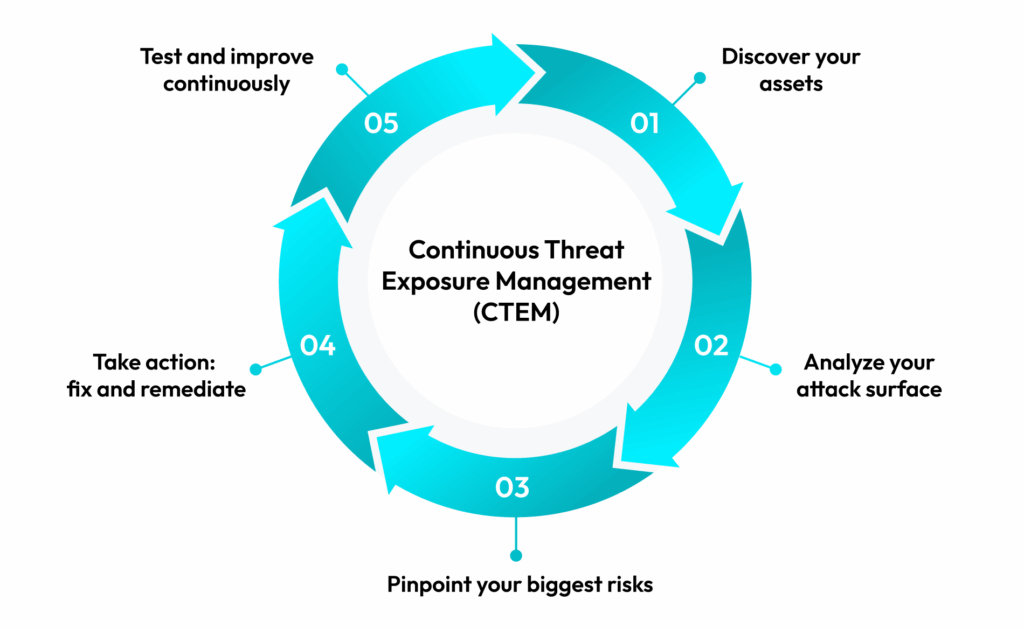This article introduces the modern playbook for proactive cybersecurity: exposure management done right.
A reactive, patch-centric approach to security doesn’t cut it anymore. It’s like a boxing champion from a different era who achieved success at the time, but… The rulebook has changed, the fighting styles have evolved, the opponents are not what they used to be, and he’s no longer the same fighter.
Discover how a thorough and continuous strategy that goes beyond traditional vulnerability management is crucial for protecting your organization’s digital estate and building resilience that is undeterred by the escalating numbers of vulnerabilities and threats.
What Is Exposure Management?
Imagine your digital and physical assets as a sprawling estate with myriad doors, windows, and underground tunnels.
Well, exposure management doesn’t check only whether the main gates (in this case, vulnerabilities) are locked. Instead, it makes sure that you have mapped every conceivable entry point—that means misconfigured smart locks, unlocked service entrances in the cloud, and even blueprints carelessly left on a public bench—no risk can escape its sight.

It recognizes that a seemingly minor oversight in one area may be the key that unlocks your most valuable treasures.
More Than Just Patching Vulnerabilities
Your organization’s security posture is an intricate ecosystem of interconnected programs, people, and processes. And exposure management is ambitiously striving to cover this entire ecosystem.
While patching is a key remediation tactic in vulnerability management, it cannot and does not play the same role in exposure management. The latter focuses on a broad scope of security problems and, hence, calls for a wider range of remediation/mitigation techniques.
This is only logical and natural since exposure management deals with non-CVE issues such as misconfigurations, legacy software, AppSec, weak credentials, and control gaps, as well as vulnerabilities in the sense of CVEs. That’s different from vulnerability management, which, as the name suggests, is preoccupied with vulnerabilities, that is, CVEs and CVSS scores.
To extend the metaphor from earlier, exposure management is about recognizing that an open window (a misconfiguration), a carelessly shared key (weak credentials), or a poorly lit alleyway leading to a back entrance (an exposed API) can be just as inviting to an attacker as any CVE out there.
By focusing on the entire landscape of potential weaknesses — both the well-known cracks and the less obvious openings — exposure management aims to harden the estate as a whole. Only then can you make it more difficult for threats to find their way in and cause damage, even if some individual doors (CVEs) remain open for a time.
How Do Attackers See Your Business?
From an attacker’s perspective, your business isn’t a collection of valuable services or a thriving community of employees. It’s a landscape of vulnerabilities and pathways to their objectives.
Threat actors constantly scan your digital and physical footprint, probing for weaknesses in your defenses — outdated software, misconfigured services, forgotten dependencies, and employees susceptible to social engineering.
Contrary to what many believe, attackers do not necessarily see hacking as an exciting endeavor ripe with subtle technical challenges. Considering the increasingly enterprise-like organization of hacking groups and e-crime, it’s just a day at work. And the more easily and painlessly they complete their tasks, the better for them.
This statement is supported by the many security incidents in the wild where malicious actors have exploited almost trivial security oversights. They look for the path of least resistance, aiming to exploit the weakest link to gain unauthorized access, steal sensitive data, disrupt operations, or abuse resources for malicious purposes.
Your business is, therefore, primarily a target-rich environment that’s always open to recon, analysis, and ultimately, exploitation.

Why Traditional Security Falls Short
Traditional security often operates with a perimeter-centric mindset. It concentrates heavily on securing the network boundary with tools like firewalls and intrusion detection systems. However, in the widely digitalized, interconnected, and cloud-native world in which we live, the perimeter has become porous and increasingly irrelevant.
Threats can originate from within and bypass traditional defenses through sophisticated AI-supported social engineering or supply chain weaknesses. Attackers can also exploit misconfigurations in the constantly evolving cloud environments, which fall outside the traditional security purview.
Moreover, the sheer volume and complexity of modern IT estates, coupled with the speed at which new vulnerabilities emerge, can only overwhelm manual and reactive approaches. Organizations are left exposed to blind spots and a constantly growing attack surface that traditional security measures are ill-equipped to monitor and handle proactively.

The Urgency of Managing Exposure Today
Proper exposure management is absolutely critical today. You must have heard this a gazillion times, but this essential need for proper exposure management springs from the profoundly changed and mountingly perilous cyber landscape.
Cloud services, remote workforces, IoT devices, and interconnected supply chains have only made the attack surface explode. At the same time, malicious actors have learned how to adapt quickly and better than ever. The development of automation and advanced technologies, such as artificial intelligence and machine learning, makes this process even easier. Just look at today’s RaaS (ransomware as a service) and social engineering.
Failure to address security exposures in a timely fashion leaves your organization incredibly vulnerable to data breaches, operational disruptions, reputational damage, and regulatory penalties.
Your Expanding Digital Footprint Risk
With each new app, work tool, or data file that extends your digital footprint, you inadvertently add more access points to your environment. Some of them you know, others are not so clear. Some are built sturdy, others carry inherent security weaknesses and logical flaws.
This flourishing, interconnected sprawl becomes a hyper-appealing target for malicious actors. It gives them an always-growing array of potential entries and hidden pathways to your most valuable assets.
Ignoring the need to catalog and apply strong protection to this expanding digital estate means doing yourself a terrible disservice. Actively managing as many points of exposure across this dynamic and increasingly complex terrain isn’t just about avoiding a break-in. It’s about ensuring the integrity of your digital foundation in a landscape where threat actors are constantly learning to pick new locks and exploit unforeseen vulnerabilities.
The High Cost of Unseen Threats
If you don’t actively look for weaknesses in your digital setup, you’re essentially letting potential problems thrive in the dark. The longer these flaws go unnoticed, the more time attackers have to sneak in, bypass defenses, move around your systems, and cause damage.
The cost of dealing with a full-blown cyberattack that exploits one of these unmanaged weaknesses is virtually always far greater than the effort required to find and fix the problem in the first place.
Just look at the Equifax data breach (2017) for proof. This breach was caused by poor asset inventory and management. The company didn’t patch a known vulnerability in Apache Struts even though a patch was publicly available. Equifax had not properly inventoried its assets to make sure they were up-to-date. This neglect allowed attackers to exploit the unpatched vulnerability and access the personal data of 147 million people.
That brings us to another point: You cannot address unseen threats if you don’t know where to look in the first place. In other words, you must know the assets you have in your environment to be able to see hidden threats. The failure to track and manage the assets effectively, especially in legacy systems, was a key factor in the Equifax breach, and it can do the same disservice to you and any other organization out there.
Shifting from Defense to Offense
In the face of today’s sprawling digital attack surface and sophisticated adversaries, effective exposure management demands a shift towards an offensive mindset. Instead of passively waiting for cyberattacks, your organization needs to search for and exploit its own vulnerabilities proactively.
How? Through techniques like penetration testing and red teaming. They can help you identify hidden weaknesses and understand potential attack paths before malicious actors exploit them. This attacker-centric approach allows for early remediation of critical exposures and a more accurate prioritization of security efforts, making it one of the landmarks of exposure management.
The ultimate goal of offensive security is to boost the overall security posture and reduce the likelihood of successful cyberattacks through preemptive and highly controlled attack simulations.
Protecting Trust and Your Bottom Line
A single cyberattack stemming from neglected exposure can erode customer confidence. It can disrupt operations, damage brand reputation, and lead to lawsuits and legal fines. All of these translate easily into lost credibility on top of monetary damage.
On the contrary, when you manage exposure proactively, finding and addressing security weaknesses before attackers discover and exploit them, you work on a long-lasting relationship of trust and confidence with your clients and partners.
Therefore, this proactive approach turns out to be more than just a security necessity; it’s a crucial business strategy and an investment in resilience, customer trust, business continuity, financial health, and long-term viability.
The Exposure Management Lifecycle
Effective exposure management is a cyclic, not linear, process. Its purpose is to help you understand and address weaknesses before threat actors exploit them. This proactive approach consists of five essential and iterative phases:
- Discover all your digital assets
In this initial phase, you create an inventory of every resource/asset your organization owns or uses, from on-premises servers and cloud instances to applications, endpoints, and data repositories. Knowing your entire attack surface is the very foundation of effective protection.
- Analyze your true attack surface
Once you know what you have, the next step is to understand what makes it vulnerable. This phase helps you analyze possible entry points and pathways, such as software vulnerabilities, misconfigurations, underprotected internet-facing interfaces, flawed business logic, and even human factors.
- Pinpoint your biggest risks first
When you understand your attack surface, the next step is to prioritize exposures for remediation. That allows you to focus only on the exposures that pose the highest threat to your critical assets and business operations.
Prioritization is where exposure management differs markedly from vulnerability management. Instead of following generic severity scores, exposure management carries out a context-based prioritization. That means it gives precedence to addressing known exploited vulnerabilities that pose the highest risk to your particular organization and vertical, regardless of their severity scores.
This effort is selective, meaning it enables you to discard the need for addressing an overwhelmingly large number of vulnerabilities that may have high severity scores but are not particularly relevant to your situation.
Nonetheless, it’s worth noting that, regardless of the revolutionarity of context-based prioritization, not every tool relies on it to reduce your attack surface. A mitigation-first security solution, for instance, takes a different approach, where reducing exposure doesn’t hinge on prioritization. But more on that later.
- Take action: fix and remediate
In this implementation phase, you start addressing practically all the identified threat exposures. Applying mitigation, patching software, adjusting configurations, adding security controls, or even retiring vulnerable systems are all possible techniques to use in this phase.
- Test and improve continuously
Security is not a static state. After taking action, it’s necessary to validate the effectiveness of your previous steps through ongoing testing. The insights gained from these tests feed back into the lifecycle, allowing you to keep refining your processes, adapting to emerging threats, and taking into account new changes in your environment.

Smart Exposure Management Strategies for US Organizations
The following practices provide a roadmap for building a robust and proactive security posture in line with the principles of exposure management.
Unify Your Security Data Streams
For US organizations, navigating an increasingly complex threat landscape in parallel with meeting stringent regulatory requirements has become quite a challenge, to say the least. One of the best strategies to overcome this challenge is practicing smart exposure management that unifies disparate security data streams.
Siloed information from vulnerability scanners, endpoint detection tools, cloud security platforms, and threat intelligence feeds creates blind spots and delays key insights. That’s why data centralization and correlation are key.
These two help you gain a holistic view of your actual attack surface, which allows for faster identification of critical exposures. That, in turn, leads to improved prioritization based on real-time risk analysis and helps improve compliance reporting.
Use Automation for Faster Insights
Everything is speeding up, including time to exploit. And we’ll be completely honest with you: Catching up with new vulnerabilities, threats, zero-days, and whatnot with manual cybersecurity workflows is unattainable—full stop.
Automating as many of the exposure management aspects as possible has become a no-brainer. It supports incomparably quicker understanding of your organization’s attack surface and the most critical threats demanding immediate attention. Most importantly, it allows for a much swifter remediation or response, and that’s the main goal, isn’t it?
Foster Security Across All Teams
Effective exposure management transcends the IT department. It requires a culture of shared responsibilities across different teams and departments.
Instead of siloed security practices, create a unified front where developers code with security best practices in mind, the marketing team understands the risks of exposed data in campaigns, and the HR reps recognize their role in preventing social engineering. In addition, encourage open communication and provide accessible security training customized for different roles.
When you embed security considerations into every team’s day-to-day, you can transform your organization’s collective awareness into a powerful, distributed sensor network. This holistic approach makes it possible for exposures to be identified and addressed earlier and more thoroughly than relying solely on a single centralized security team.
Adapt Tactics for Your Industry Needs
A one-size-fits-all approach to reducing attack surfaces is a recipe for inadequacy, especially for US organizations operating within diverse and heavily regulated industries. Smart tactics recognize that the threat landscape, regulatory requirements (HIPAA, PCI DSS, or FISMA), and critical asset profiles can vary wildly across sectors.
That’s why exposure management is invaluable. It doesn’t rest on assumptions such as the one that high severity is a high priority. Instead, it allows you to shape your security tactics in line with your industry’s unique requirements, both security and compliance requirements.
This bespoke approach enables you to concentrate resources on the most relevant threats and implement security controls that match the specific risks and regulatory demands of your operational environment.
How to Navigate Key US Regulations in Exposure Management
Compliance is a core aspect of cybersecurity. Moreover, for many organizations, compliance requirements are the very basis for their cybersecurity programs. How do you meet compliance demands in conjunction with exposure management?
Know Major Compliance Rules
Navigating the US regulatory landscape requires a clear understanding of major compliance rules relevant to your industry, such as HIPAA, PCI DSS, or SOX. But keep in mind that often you must adhere to the rules of regulations outside of the US, such as GDPR, if your operations include citizens of other regions.
For this reason, you must carry out diligent research and clearly understand which compliance requirements apply to you and which you shouldn’t stress about. Ignoring requirements exposes your organization to legal and financial penalties, threatens to damage your reputation, and jeopardizes your relationship with customers and partners.
That makes proactive identification and adhering to key regulations a pivotal aspect of responsible business operations and long-term sustainability in the US market.
Simplify Your Reporting
Complex reporting is typically an indispensable part of compliance requirements. Simplifying this process through standardized formats, automated data collection, and clear communication channels saves you tons of time and resources, and also decreases the probability of errors creeping into the process.
By streamlining reporting in these ways, you can better focus on adhering to the substance of regulations instead of being overwhelmed by the administrative overhead.
Prepare for Evolving Legal Standards
US regulations are anything but static. Legal standards are always changing in response to technological developments, new threats, and societal shifts.
Prepare for these changes. Stay updated with upcoming legislation. Try to understand its impact on your organization’s operations beforehand, and, above all, build a flexible compliance framework that can carry its value over longer periods.
Not being able to foresee and prepare for major changes on time lowers your compliance preparedness. It makes you vulnerable to new legal challenges and compromises your ability to operate uninterruptedly in the future.
How to Overcome Common Challenges in Exposure Management
Like everything else, the practical realization of exposure management’s tenets is often plagued by equally practical challenges. An exhaustive list of these would require a discussion on its own. Here, we’ll look at four common obstacles.
Cut Through Tool and Alert Noise
A big hurdle in exposure management is the flood of alerts and data from security tools. The sad truth is that a slew of tools can often create more noise than actionable intelligence.
To overcome this predicament, focus on unifying and correlating security-relevant data streams. Automation and intelligent analytics, especially when powered by AI and ML engines, can also be tremendously helpful. They’ll help you filter out irrelevant alerts and identify high-fidelity critical signals pointing to genuine risk.
This way, security teams can cut through the vulnerability/alert noise and focus their limited resources on tackling the most pressing exposures. The outcome? More on-time remediation and quicker response times for a better security posture.
Align IT and Security Goals
The misalignment between IT operational priorities and security objectives is another colossal problem. Handling it comes down to breaking siloes.
Sharing understanding and common goals between IT and security teams should become an integral part of your organization’s culture. When you integrate security considerations into IT planning, development, and deployment — instead of treating them as separate or even conflicting priorities — you’re already halfway to fixing exposures.
Therefore, build an inherently secure and resilient digital environment by forging a culture of security, where ITOPs teams function as two integral parts of a single whole, as opposed to two wholes constantly on the verge of collision.
Gain Leadership Support and Budget
Securing leadership buy-in and an adequate budget for exposure management is yet another challenge.
The truth is that this often hinges on clear articulation of the business risks associated with unmanaged vulnerabilities, along with the ROI of proactive security measures. By framing exposure management as primarily a business enabler, you can represent it as a strategic imperative that protects critical assets, ensures operational/business continuity, and dodges costly breaches and regulatory fines.
This seems to be the path for security teams to communicate their value proposition to leadership and justify the financial commitment successfully. Demonstrating a clear roadmap and measurable outcomes further strengthens the case for sustained support and resource allocation.
Do More with Limited Resources
“Do more with limited resources” sounds like an impossible mission, but it’s not as far-fetched a possibility as it may seem at first glance.
How so?
Well, automation and AI/ML technologies turn this motto into a plausible option. They’re all about efficiency—and in cybersecurity, efficiency is paramount. Faster and precise asset discovery, vulnerability scanning, and risk prioritization with minimal waste of resources is, essentially, what we’re all after.
Automation and artificial intelligence allow you to bridge the gaps of limited personnel, budget, and resources, and still achieve the desired results in the form of addressed critical threat exposures.
Advanced Exposure Management Methods and Future Trends
Among the many advanced methods available for managing exposure, scenario testing and AI-based technologies stand out as two of the most effective. Their growing adoption reflects a shift toward proactive security, and this trend will likely continue well into the future.
How Scenario Testing Builds Resilience
Scenario testing has proven over and over again to be a powerful exposure management tactic. It simulates realistic attack scenarios against your organization’s digital environment with the aim of pinpointing exploitable weaknesses in your environment. Scenario testing can take the form of pentesting or red teaming.
The simulation of how threat actors might exploit identified exposures helps you reliably identify weaknesses in your defense and incident response plan before an actual cyberattack happens. It’s proactive security par excellence and allows for the refinement of security controls, the development of effective response strategies, and the strengthening of your organization’s resilience.
AI’s Growing Role in Risk Prediction
We’ve already mentioned AI on a few occasions, and rightly so. Thanks to its ability to analyze enormous datasets with impressive exactness, its role in exposure management is on the rise.
Whether they make inferences from historical attack patterns, threat intelligence, or real-time network activity, AI agents can identify subtle IOCs (indicators of compromise) and even predict possible future threats. What’s more, they can achieve this feat with far greater accuracy and speed than manual methods.
Instead of a Conclusion: The Next Evolutionary Step in Exposure Tech
For all its worth, exposure management, as it’s currently done, is still not where it should be. All other things aside, we see the main problem in its time to remediate.
Standard exposure management may have sped things up, but it still takes too long to address critical vulnerabilities and exposures. Its focus has indeed shifted from patching to a wider scope of remediation techniques—we include mitigation here as well—but more often than not, it takes forever for an organization to reach arguably the most important exposure management phase: remediation.
That’s all precious time that attackers can use to exploit an exposure and run circles around security teams while they’re still analyzing and prioritizing.
The path forward is to make remediation, in the form of mitigation, a primary step not just in importance but also chronologically. But how is it possible to address vulnerabilities and misconfigurations before analyzing and prioritizing them?
The answer lies in autonomous exposure mitigation. It means a reliable mitigation-first approach applied without human intervention and independently of long patching cycles.
Currently, the only complete embodiment of this technology is OTTOGUARD.AI by Virsec. It’s a workload patchless mitigation platform powered by AI and a patented zero-trust technology. What makes it stand out is its capability to mitigate vulnerabilities and security weaknesses right off the bat.
OTTOGUARD.AI’s main goal is to prevent threats from causing harm through real-time monitoring and response. It can block attacks in milliseconds, regardless of whether they come through the software supply chain, target legacy software, or try to execute malware in your application workloads at runtime. Most importantly, it applies mitigation mechanisms across the board as the first step in exposure management.
Don’t worry; this is not magic. There’s a perfectly reasonable technological explanation of how OTTOGUARD.AI works to achieve this feat. Want to discover how?
Book a demo and experience exposure management done right.
FAQs
A vulnerability is a security weakness that can be exploited, while an exposure is a broader condition where your assets are accessible and could be harmed. This is often because of a vulnerability, but also due to misconfigurations, subpar access controls, poor identity management, and similar weaknesses.
Exposure management is the proactive and continuous process of identifying, analyzing, prioritizing, and mitigating an organization’s attack surface and potential pathways for cyber threats across its entire digital ecosystem.
Given the escalating sophistication and frequency of cyberattacks targeting US businesses, coupled with an expanding digital landscape and stringent regulatory demands, proactive exposure management is essential to prevent costly breaches, maintain operational resilience, and ensure compliance.
Exposure management done right is a business enabler; it reduces the likelihood of devastating cyberattacks, promotes operational continuity, and safeguards your reputation and customer trust.




